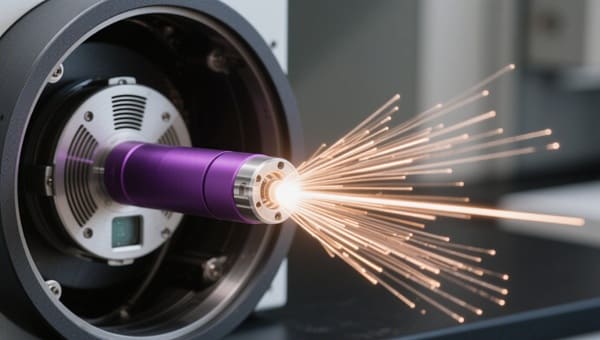Why Is LaB6 an Ideal Choice for Semiconductor Applications?
In the ever-evolving semiconductor industry, material selection plays a crucial role in determining the performance, efficiency, and reliability of devices and manufacturing equipment. Lanthanum Hexaboride (LaB6) has emerged as a standout material, especially for electron emission applications, thanks to its unique combination of electrical conductivity, thermal stability, and low work function. This article explores why LaB6 is regarded as an ideal material for semiconductor applications, offering deep insights into its properties, comparisons with other materials, specific uses, and future potential in next-generation semiconductor technologies.
At Advanced Ceramic Hub, we specialize in high-quality LaB6 products, ensuring optimal performance for industrial and scientific applications.

What is LaB6?
LaB6, or Lanthanum Hexaboride, is a refractory ceramic composed of lanthanum and boron. It is known for its bright purple-violet color and metallic luster, and more importantly, for its remarkable physical and chemical properties. LaB6 has a very high melting point (over 2700°C), high electron emissivity, and excellent thermal and chemical stability in vacuum environments. These characteristics make it a preferred material for cathodes, emitters, and coatings in high-tech applications.
LaB6 is not just another ceramic—it is electrically conductive and stable under extreme conditions, which makes it different from most conventional insulating ceramics. It combines metallic-like conductivity with the thermal resilience of ceramics, positioning it as a hybrid material suited for high-precision and high-demand technologies.
Basic Properties of LaB6:
| Property | Value | Unit |
| Melting Point | ~2715 | °C |
| Work Function | ~2.4 | eV |
| Electrical Conductivity | High | — |
| Thermal Stability | Excellent | — |
| Density | ~4.72 | g/cm³ |
These properties highlight LaB6’s capacity to deliver consistent performance in environments where conventional materials like tungsten may degrade or fail.
Explore our high-quality LaB6 ceramic product.
How Does LaB6 Compare to Traditional Cathode Materials?
Traditional cathode materials such as tungsten and tantalum have long been used in semiconductor systems due to their high melting points. However, these materials often fall short in terms of efficiency, electron emission density, and operational life. LaB6, with its lower work function and higher emission efficiency, offers significant advantages over these legacy materials.
One of the most notable distinctions is LaB6’s ability to emit electrons at significantly lower temperatures, which reduces energy consumption and prolongs device life. Additionally, LaB6 exhibits greater chemical stability, reducing the risk of contamination in ultra-high vacuum (UHV) environments—an essential factor in semiconductor processing.
Comparison Table: LaB6 vs. Common Cathode Materials:
| Material | Work Function (eV) | Emission Current Density | Lifespan | Oxidation Resistance | Typical Operating Temp |
| LaB6 | ~2.4 | High | 5,000+ hours | Moderate | 1500–1800°C |
| Tungsten | ~4.5 | Moderate | 500–1000 hours | Low | >2200°C |
| Tantalum | ~4.2 | Low | <500 hours | Low | ~2000°C |
These figures illustrate why LaB6 is increasingly replacing tungsten in electron beam sources and SEM cathodes.
What Makes LaB6 Thermionically Efficient?
Thermionic emission is a fundamental process in many semiconductor and vacuum applications. It involves the release of electrons from a heated material, and efficiency is largely dictated by the material’s work function and stability at high temperatures.
LaB6 shines in this regard. Its low work function of ~2.4 eV enables high electron emission at relatively low operational temperatures. This reduces power consumption, thermal stress, and the risk of component failure. Additionally, LaB6 maintains a stable emission rate over time, even under continuous use in demanding conditions.
Thermionic Emission Advantages of LaB6:
- Lower operating temperatures reduce thermal degradation
- Higher current density enables more efficient emission
- Longer cathode life reduces downtime and replacement cost
- Stable output improves performance in precision applications
These features make LaB6 a preferred material for electron beam lithography, SEM, and other advanced tools requiring reliable electron sources.
How Stable is LaB6 Under High Temperatures?
High-temperature resilience is critical in many semiconductor processes involving plasma, vacuum chambers, and thermal evaporation. LaB6 retains structural and functional integrity even under sustained exposure to extreme heat, which enhances its reliability and longevity in production environments.
However, like many borides, LaB6 can oxidize when exposed to oxygen at high temperatures. Therefore, it’s typically used in vacuum or inert environments. With proper system design, such as protective coatings or sealed cathode chambers, oxidation risks can be mitigated.
High-Temperature Performance of LaB6:
| Condition | Result |
| Vacuum (>10⁻⁵ Torr) | Thermionic stability maintained |
| Inert Gas Atmosphere | Good performance with minor precautions |
| Oxidizing Atmosphere | Surface degradation above 600°C |
| Long-Term Heating | Stable structure and emission |
These results confirm LaB6’s suitability for thermally intense, vacuum-based semiconductor applications.
What Are the Key Semiconductor Applications of LaB6?
LaB6 is used in various high-precision, high-efficiency applications where traditional materials cannot meet the performance requirements. These include not only cathodes in electron beam systems but also thermionic filaments, probe tips, and protective coatings.
Its role in semiconductor applications includes supporting the fabrication of integrated circuits (ICs), mask alignment, and high-resolution imaging—areas that demand stability, consistency, and longevity.
Common Semiconductor Applications of LaB6:
- Electron beam lithography systems: High-resolution patterning
- Scanning/Transmission Electron Microscopes (SEM/TEM): Stable cathodes
- Vacuum thermal deposition: Consistent emission sources
- Etching and deposition systems: High-temperature plasma resistance
- Focused ion beam (FIB) tools: Precise emitter tips
LaB6’s contribution to these tools is foundational, enabling accurate and reliable semiconductor processing at nanoscale levels.
How Does LaB6 Perform Compared to Other Advanced Ceramics?
While materials like silicon nitride (Si₃N₄) and boron carbide (B₄C) excel in hardness and wear resistance, they lack the conductivity and emission properties needed for semiconductor emitters. LaB6 uniquely blends metallic behavior with ceramic durability, giving it a competitive edge in thermal-electrical roles.
| Property | LaB6 | Si₃N₄ | B₄C |
| Conductivity | High | Low | Low |
| Hardness (GPa) | ~15 | ~16 | ~30 |
| Work Function | ~2.4 eV | Not Applicable | Not Applicable |
| Thermal Stability | Excellent | Excellent | Moderate |
| Semiconductor Use | High | Low | Limited |
This table shows that LaB6 occupies a unique position that few other materials can compete with in emission-based systems.
Request a custom quote for the LaB6 ceramic product.
Is LaB6 Compatible with Modern Semiconductor Manufacturing?
Yes—LaB6 is highly compatible with today’s semiconductor manufacturing requirements. It integrates well into ultra-high vacuum systems, shows low contamination risk, and is capable of being formed into various shapes such as rods, filaments, and coatings for complex cathode assemblies.
Furthermore, LaB6 components are often available in machined or sintered formats that meet exacting precision standards, making them suitable for OEM system integration.
Manufacturing Advantages of LaB6:
- High purity and low outgassing in UHV systems
- Can be custom-machined to exact dimensions
- Surface coatings extend oxidation resistance
- Supports long operational lifetimes, reducing maintenance
These features make LaB6 a highly adaptable and long-lasting choice for demanding industrial settings.
What’s the Future of LaB6 in Semiconductor Applications?
As semiconductor devices continue to scale down in size and increase in complexity, the demand for more precise, stable, and efficient materials grows. LaB6 is well-positioned to meet this demand, especially in fields like quantum computing, EUV lithography, and nanoscale electronics.
In addition to its core roles, research is ongoing into modifying LaB6 structures to improve oxidation resistance and emission control. Nanostructured LaB6, doped variants, and advanced coatings may push performance boundaries even further.
Emerging Roles for LaB6:
- Electron sources for EUV lithography
- Cold cathode field emission systems
- Compact and mobile SEMs for in-field diagnostics
- High-brightness display technologies
- Vacuum electronics for aerospace and defense
As new frontiers in chip design and fabrication emerge, LaB6 is likely to become even more essential to next-generation manufacturing.
FAQ
| Question | Answer |
| Is LaB6 toxic or hazardous? | Solid LaB6 is stable and safe; dust may require precautions. |
| Can LaB6 replace tungsten entirely? | Yes, especially in vacuum or high-performance systems. |
| Does LaB6 need special storage? | Should be kept in dry, low-oxygen environments. |
| Is LaB6 difficult to machine? | Yes, but possible with diamond tools under controlled conditions. |
| How long do LaB6 cathodes last? | Typically up to 10× longer than tungsten equivalents. |
Conclusion
LaB6 represents a critical advancement in material science for semiconductor technology. Its combination of low work function, high emission efficiency, and superior thermal stability makes it indispensable in electron beam tools and high-vacuum systems. Unlike traditional cathode materials, LaB6 provides long service life and operational efficiency, directly contributing to better performance and cost savings. As semiconductor technologies advance, LaB6 will remain a key material—bridging today’s challenges with tomorrow’s breakthroughs.
Looking for high-quality LaB6 product? Contact us today!
